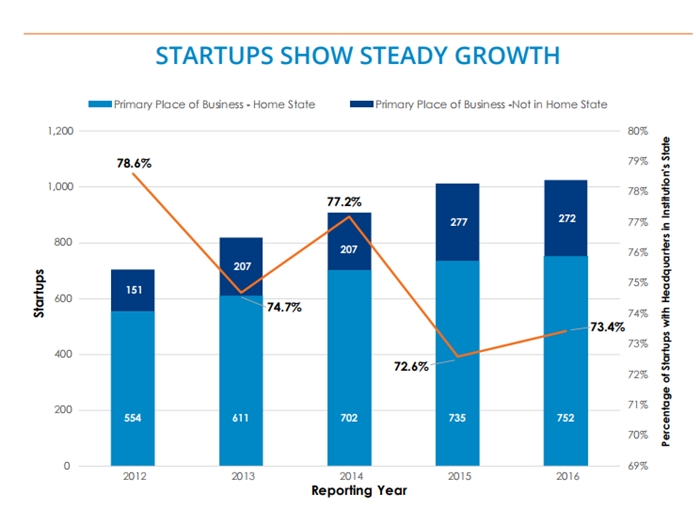28 November 2017. A survey of universities and other institutions shows the number of patent filings and new start-up companies resulting from federally-funded research climbed in 2016. The annual poll by Association of University Technology Managers, or AUTM, also reports a sharp increase in the number of start-up enterprises that ceased operations in 2016.
The annual survey compiled data on research funding, intellectual property, and start-up activity from 195 universities, research institutes, and hospitals in the U.S., out of 309 institutions queried. The results show 1,024 new companies were formed to commercialize research conducted at these institutions, up slightly from the 1,012 new companies formed in 2015, a rate of nearly 3 start-ups per day. Nearly three-quarters of these new enterprises (73%) are located in the same states as the institutions. In addition, companies formed from scientific research turned out some 800 new products in 2016.
At the same time, 331 companies based on science closed in 2016, an increase of 37 percent from 2015. Nearly 500 of these new start-ups provided equity to the institutions holding the intellectual property rights to the technology, as compensation for licensing the technology for commercialization. Taking equity for licenses helps conserve cash in a start-up company.
The survey shows patenting by research institutions continued with steady gains compared to 2015. The number of provisional patent applications, an early form of patent placeholder, increased to 12,114 filings in 2016, a 5 percent increase over 2015. Nearly 16,500 new patents based on research at these institutions were filed in 2016, an increase of 3 percent compared to 2015, while more than 7,000 new U.S. patents were issued to the institutions in 2016, a 5 percent gain over the previous year.
Patent applications filed outside the U.S. jumped by a third (34%) in 2016. “There are many reasons,” says Mary Albertson, president of AUTM, referring to this increase in a statement, “including a wider dissemination of U.S. inventions worldwide and a desire for stronger patent rights outside the United States because of recent anti-patent case law and legislation.”
Another indicator of research commercialization is invention disclosures, where researchers report internally on new and innovative discoveries with market potential before filing a patent. The number of new invention disclosures, says AUTM, has been increasing over the past 5 years, and now reaches nearly 26,000, an average of 133 disclosures per responding institution.
Data on licensing and royalties at these institutions reveals a mixed picture. Most (70%) licenses of intellectual property at reporting institutions went to small and start-up companies, while licensing with larger companies declined by 16 percent compared to 2015. In addition, individual licenses generating more than $1 million remains less than 1 percent of the total. Income from licensing and royalties to the institutions in 2016 increased nearly 18 percent compared to 2015, but much of that gain is attributed to special factors that prevented some institutions from reporting in 2015.
The findings also indicate less interest in licensing and options — an intent to license — involving risk. In 2016, the institutions report a 7 percent drop in option agreements, as well as 2 percent decrease in exclusive licenses compared to 2015. The number of non-exclusive licenses, however, increased by 2 percent.
More from Science & Enterprise:
- Biotech Licenses Mayo Clinic Microbiome Research
- Start-Up Formed to Develop Non-Opioid Pain Drugs
- Univ. Lab, Company Broaden Bacterial Vaccine Impact
- Univ. Spin-Off Reports Cancer Immunotherapy Advance
- University Spins Off Educational Robot Start-Up
* * *


 RSS - Posts
RSS - Posts
You must be logged in to post a comment.